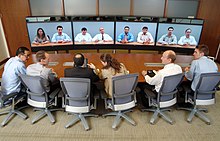
Back تهاتف مرئي Arabic Videotelefoniya AZ ভিডিওটেলিফোনি Bengali/Bangla ڤیدیۆ کۆنفراس CKB Videotelefonio EO Videochat Spanish Bideotxat EU خدمات تلفن تصویری FA Videopuhelu Finnish Videochat GL
This article's lead section may be too short to adequately summarize the key points. (November 2024) |

Videotelephony (also known as videoconferencing or video calling) is the use of audio and video for simultaneous two-way communication.[1] Today, videotelephony is widespread. There are many terms to refer to videotelephony. Videophones are standalone devices for video calling (compare Telephone). In the present day, devices like smartphones and computers are capable of video calling, reducing the demand for separate videophones. Videoconferencing implies group communication.[2] Videoconferencing is used in telepresence, whose goal is to create the illusion that remote participants are in the same room.
The concept of videotelephony was conceived in the late 19th century, and versions were available to the public starting in the 1930s. Early demonstrations were installed at booths in post offices and shown at various world expositions. In 1970, AT&T launched the first commercial personal videotelephone system. In addition to videophones, there existed image phones which exchanged still images between units every few seconds over conventional telephone lines. The development of advanced video codecs, more powerful CPUs, and high-bandwidth Internet service in the late 1990s allowed digital videophones to provide high-quality low-cost color service between users almost any place in the world.
Applications of videotelephony include sign language transmission for deaf and speech-impaired people, distance education, telemedicine, and overcoming mobility issues. News media organizations have used videotelephony for broadcasting.[citation needed]